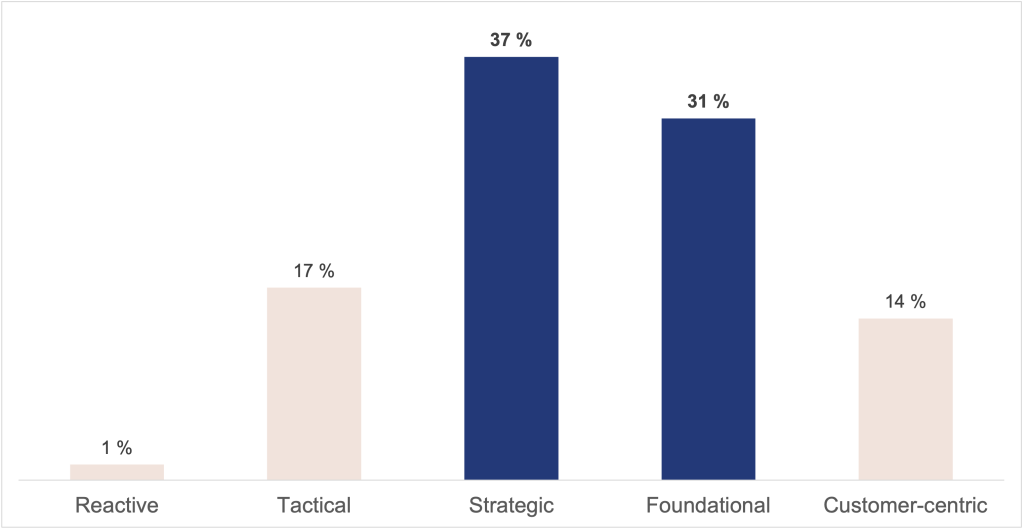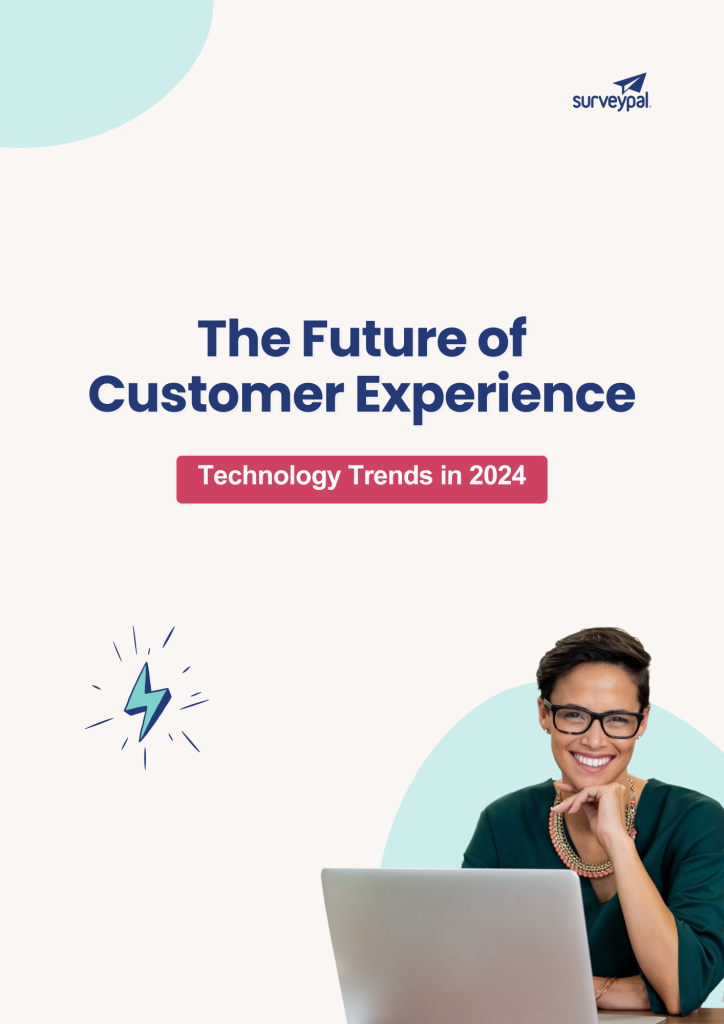Recent years have seen significant progress in AI technology, bringing important implications for the future of Customer Experience (CX). These advancements are shaping a new era in CX, transforming areas like customer service operations, feedback management, and customer satisfaction.
As customer experience continues to evolve, embracing AI technology is essential for CX leaders to deliver exceptional, personalized experiences that customers expect. In this article, we explore insights from the Surveypal Study “The Future of Customer Experience: Technology Trends” based on interviews with global CX leaders and a comprehensive survey of CX professionals.
Key AI Applications in Customer Experience
AI has the power to improve various aspects of customer interactions. The main AI applications in CX include predictive analytics, sentiment analysis, and text analysis.
Predictive Analytics
Predictive analytics uses AI algorithms to analyze historical data and forecast future customer behaviors. By identifying patterns and trends, it helps businesses anticipate customer needs and preferences.
Use Cases of Predictive Analytics:
- Personalized Recommendations: Online retailers use predictive analytics to suggest products based on a customer’s past purchases and browsing history. For instance, Amazon’s recommendation engine is a prime example of how predictive analytics can drive sales and enhance customer satisfaction.
- Proactive Support: Predictive models can alert service teams to potential issues before they arise, allowing them to reach out to customers proactively. This can significantly reduce churn and improve the overall customer experience.
Benefits of Predictive Analytics:
- Enhanced Personalization: By understanding future behaviors, businesses can tailor their interactions to individual customer preferences, making experiences more relevant and engaging.
- Improved Customer Retention: Anticipating customer needs helps in addressing issues before they escalate, thus maintaining high levels of customer satisfaction and loyalty.
- Operational Efficiency: Predictive analytics streamlines processes by focusing resources on high-impact areas, improving the efficiency of marketing and customer service operations.
Sentiment Analysis
Sentiment analysis involves AI analyzing customer feedback to determine their emotions and opinions. This helps businesses understand how customers feel about their products and services in real-time.
Sentiment Analysis Techniques:
- Natural Language Processing (NLP): NLP algorithms process text data from customer reviews, social media, and surveys to detect sentiment.
- Machine Learning Models: These models classify feedback as positive, negative, or neutral and can identify underlying emotions such as anger, joy, or frustration.
Benefits of Sentiment Analysis:
- Customer Service: By identifying dissatisfied customers through sentiment analysis, businesses can quickly address their concerns, improving service quality and customer loyalty.
- Feedback Management: Sentiment analysis provides a continuous feedback loop, enabling companies to adapt their strategies based on real-time customer insights. This helps in refining products and services to better meet customer expectations.
Text Analysis
Text analysis, also known as natural language processing (NLP), enables AI to interpret and analyze human language in various forms. It is crucial for automating customer interactions and generating insights from unstructured data.
Use Cases of Text Analysis:
- Customer Support: AI-powered chatbots use text analysis to understand and respond to customer inquiries, providing instant support and resolving common issues efficiently.
- Feedback Analysis: Text analysis tools scan customer feedback from various sources, categorizing and prioritizing it to ensure critical issues are addressed promptly.
- Social Media Monitoring: Businesses use text analysis to track and analyze customer conversations on social media, gaining insights into public perception and emerging trends.
Benefits of Text Analysis:
Text analysis helps businesses gain a deeper understanding of customer needs and preferences by extracting valuable insights from large volumes of textual data. This enhances the ability to tailor products, services, and interactions to meet customer expectations better.
Combining these AI applications allows businesses to deliver more personalized, timely, and relevant customer experiences.
The Role of CX Maturity in Technology Adoption
Organizations are in different stages of the customer experience journey, with varying levels of CX maturity. Our research findings indicate that the levels of technology adoption are higher as CX maturity increases.
These are the 5 levels of CX maturity:
1 Reactive: Companies with a rudimentary understanding of their customers.
2 Tactical: Companies that have had occasional forays into customer research.
3 Strategic: Companies with enough customer-related initiatives aligning research and analysis efforts.
4 Foundational: Companies whose CX efforts are coordinated and fit intentionally within well-articulated strategies.
5 Customer-centric: Companies structured primarily around the measurable satisfaction of their customers’ needs.
In our study, most surveyed organizations (66%) were either at the Strategic or Foundational levels of CX maturity. Only a small portion (15%) were genuinely customer-centric based on their approach to customer experience. The research found a positive correlation between CX maturity and technology adoption suggesting that more CX-mature organizations are more likely to adopt new technologies as part of their customer experience processes.

Obstacles to Technology Adoption: Privacy Concerns Not the Top
When deciding whether or not to adopt some new technology, CX leaders can face a series of obstacles and concerns. While privacy and security concerns are significant, our research found that they are not the primary reasons organizations hesitate to try new CX technologies.
Integrating new technology with existing systems was the main challenge in technology adoption according to 30% of CX leaders who participated in the survey. Organizational culture and budget were also among the main challenges faced by organizations when adopting new technologies.

Although most organizations in the survey declared to be cautious regarding new technology adoption (56%), only 13% mentioned data privacy and security as their main concern, suggesting that operational, financial, and cultural issues play a bigger role in their decisions.
Human Connection and Empathy Prevail
According to the study, the overall consensus is that, although technology will play a significant role in the future of customer experience, preserving human interaction and empathy remains critical for effective CX management. Very few (8%) CX professionals believe that a reduced need for human representatives is what best describes the future of CX when it comes to the role of the customer service agent. Most CX professionals believe that an increased focus on complex problem-solving and empathy will define the new role of agents.

Technology can enhance efficiency and personalization, but it cannot fully replace the emotional intelligence and understanding that human interactions provide. Empathy helps build trust and loyalty, making customers feel valued and understood. This human touch is essential for resolving complex issues, understanding nuanced customer needs, and providing a personalized experience that technology alone cannot achieve.
Final Thoughts On The Future of Customer Experience
Several key themes will be central to CX as technology evolves, including the integration of data, a reduction in manual tasks, a movement towards more personalized customer service, and a potential shift back to in-house customer service operations. The increasing importance of AI is evident, with predictions indicating enhanced efficiency, quicker response times, and a transformation from a service-centric agent team to a more advisory or sales-oriented team.
CX leaders foresee a greater reliance on automation and self-service functionalities, emphasizing the need to strike a balance between human interaction and AI capabilities. Additionally, the industry anticipates a shift towards more proactive, data-driven customer service, incorporating the integration of AI, automation, and analytics. Despite the obstacles to technology adoption, prioritizing empathy and human connection will ensure that customer interactions remain meaningful and impactful in the new era of customer experience.

“The Future of Customer Experience” report by Surveypal is based on insights from over a hundred CX professionals, providing a panoramic view of the evolving CX landscape and shedding light on the benefits and challenges associated with the integration of Artificial Intelligence (AI). Download the full report to read:
- The technology trends that will redefine CX strategies in the coming years
- A deep dive into the role of Artificial Intelligence in CX
- Perspectives on the future of CX from more than a hundred CX professionals
Did you like the post?
You might also like:

Surveypal
Everything you need to lead and improve your customer experience. Learn more at surveypal.com, or






